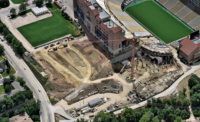Ministry of Defense Complex
Kabul, Afghanistan
Best Project
Owner Air Force Civil Engineering Center, on behalf of the Combined Security Transition Command Afghanistan
Contractor Gilbane Federal
Lead Designer, Structural and MEP Engineer STUP Consultants Pvt. Ltd.
Civil Engineer Gilbane Federal
Subcontractors Sabawoon Salim Construction Co.; Harirod Construction
In May 2015, U.S.-based contractor Gilbane Federal completed a sophisticated, self-sustaining 414,000-sq-ft headquarters building for the Afghanistan Ministry of Defense in Kabul.
Construction spanned six years in a politically volatile war zone. Originally envisioned as an 18-month effort when awarded in spring 2009, the project went through 14 design modifications and, at the end of 2013, an 11-month halt for lack of funding before completion in 2015, according to a February 2016 report by the special inspector general for Afghanistan reconstruction, a Congressional watchdog agent. Nevertheless, the report declares that the building generally meets the contract requirements and appears to be well built.
The project was executed by an international team of designers, consultants, suppliers and subcontractors. Gilbane was challenged to integrate an untrained 700-person local workforce, manage logistics that threaded both political and actual minefields—and by design and project management processes that linked professionals and stakeholders located from Afghanistan to India to the U.S.
The Gilbane design team value-engineered conceptual design documents from New Delhi-based STUP Consultants for construction and materials efficiencies. Revisions led to an increase in usable space and capacity and included foundation revisions for more efficient beam and column sizes, vertical alignment and consolidation of the MEP systems, as well as raising the ground-level slab elevation to mitigate water infiltration.
Construction required extensive placement of structural concrete, as the system features a cast-in-place special moment frame with reinforced masonry infill walls. To expedite work and ensure quality, Gilbane established an on-site concrete batch plant and testing laboratory.
Wholly self-contained, the building features power generation, a water production well, water treatment and storage systems, and an on-site wastewater treatment plant. A 525,000-liter underground water tank is compartmentalized for raw water, potable water and fire water. The 800,000-liter-per-day packaged wastewater treatment plant’s effluent meets World Health Organization discharge standards.
Conventional but self-contained MEP systems were installed. The building can connect to a municipal power grid but operates on a self-contained power-generation system consisting of four 2,000-kVA diesel generators in an N+1 configuration which can operate the building indefinitely.
Gilbane also developed an HVAC value-engineering concept: Rather than using a large central air-handling unit as originally specified, it determined that distributed coolant systems with local radiators would be more efficient and minimize start-up loads on the generator, reducing maintenance costs while providing more reliable operations. The system includes air-handling units to distribute fresh air throughout the building and a three-pipe variable refrigerant flow system, with variable capacity rooftop compressors and to multiple indoor units operating at varying speeds. The configuration realizes substantial energy savings at partial load conditions.
Averaging more than 31,000 work hours per month, the project had a recordable incident rate of 0.1 and experienced only two lost-time incidents, one near-miss and no fatalities.
Michael P. Sousa, the Gilbane project executive who came onto the project in 2013 to restart it after the 11-month pause, says that process had to begin with ripping out water-damaged materials and reworking some seismic details. “When I first saw it I wondered what I had gotten myself into. But it was a challenge and it was fun. It’s one of those things that was actually a good ending,” he says.






